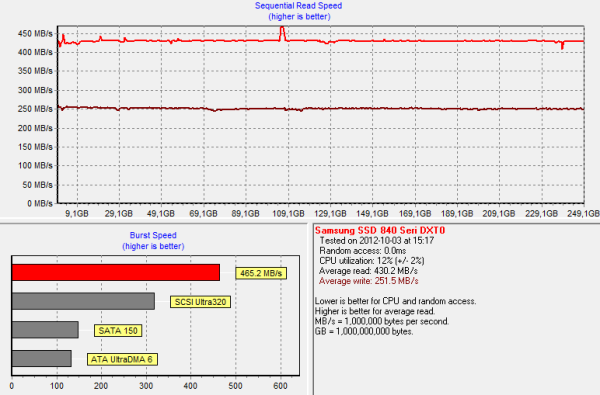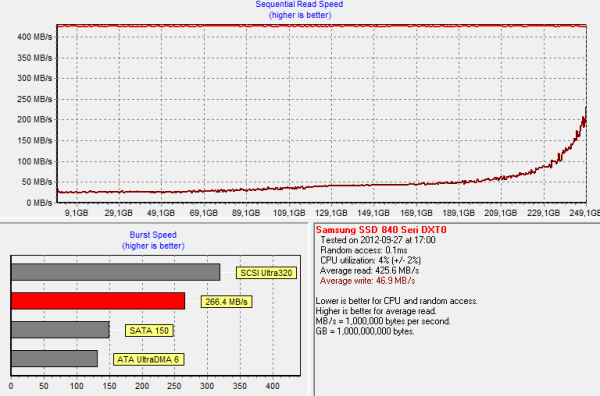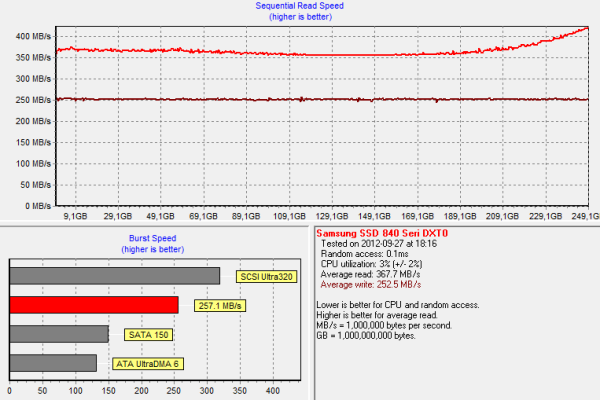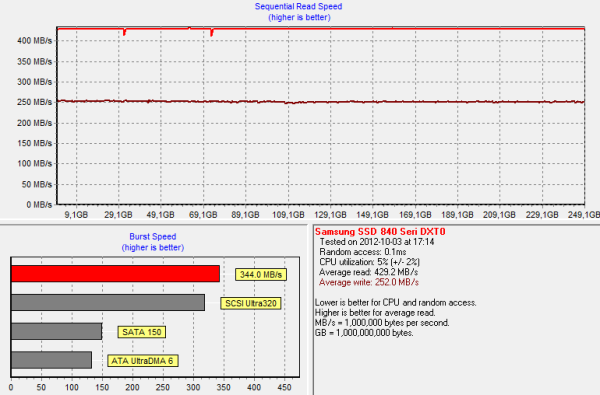Samsung SSD 840 (250GB) Review
by Kristian Vättö on October 8, 2012 12:14 PM EST- Posted in
- Storage
- SSDs
- Samsung
- TLC
- Samsung SSD 840
Performance Over Time & TRIM
For starters, I ran HDtach on a secure erased drive to get the baseline performance:
Next I secure erased the drive again, filled it with compressible data and proceeded with torturing it for 20 minutes with compressible 4KB random writes (100% LBA space, QD=32):
Ouch, performance takes a big hit. Usually 20 minutes isn't enough to put 256GB drives on their knees but it definitely is for the 840. Write speed drops to as low as 25MB/s, although it's nearly restored before all user-accessible LBAs have been filled. The way to avoid this worst case state is to keep as much free space on your drive as possible. We typically recommend around 20%, however with TLC NAND it might be advisable to bump that up to 30%. The 840 Pro will be a better option for heavy write workloads already due to its higher endurance.
To see how idle time is able to restore performance, I let the drive idle for 50 minutes:
Write speed is fully restored but for some reason, read speed is fluctuating. The drop isn't huge as we are still talking about +350MB/s at all times, but it's interesting and a bit odd to see this kind of behavior since read speed was ~425MB/s after torture.
Finally I secure erased the drive again, filled it, tortured for 20 minutes and TRIM'ed it:
Again we see some weird behavior as write speed is not fully restored after TRIM. It does get to 250MB/s at the end of the HDtach run, but the starting performance is only 150MB/s. Keep in mind that I TRIM'ed the drive right after the torture; I didn't run HDtach in between like we often do but a functioning TRIM should still fully restore performance. Remember that TRIM is still just a suggestion—it's up to the controller to prioritize TRIMed LBAs for garbage collection. Given the higher program/erase latencies with TLC NAND it's entirely possible that the 840's garbage collection routine is just slower than we're used to seeing. Another possibility is that with the fewer number of P/E cycles, the 840 is just very conservative about using them when it's not stricly necessary (e.g. ignoring some of the TRIM "suggestions").
As a final test, I TRIM'ed the drive again and ran HDtach:
And now performance is what it should be. This is mostly due to sequential writes because at the end of the previous HDtach run, write performance was already at 250MB/s.















86 Comments
View All Comments
SSDFDE - Wednesday, November 14, 2012 - link
... actually what happens if I set the IDE (sorry, its ATA actually) password in BIOS and then move the drive to another computer with no ATA HDD BIOS password set? Will it be readable there as the internal key in the drive of course still is the same?As ATA password is an option only, and setting the ATA password does not alter the internal SSD key, the actual encryption on the drive does not change at all no matter if a ATA password is set or not, right?
BTW: Resetting / generating an new internal key seems to be done with "secure erase" on hardware-encrypted drives with internal encryption key... clearly then its only bitshit on the dive once the old key is lost. Is there an option to do that an the Samsung drive anyway?
JellyRoll - Saturday, November 24, 2012 - link
Digital Signal Processing has nothing to do with the voltage states of the NAND. It is processing of the actual signal that comes from the NAND packages.DSP is used for multiple technologies, from audio to video to radar. These devices do not utilize nand, and DSP has zero interaction with the NAND itself, it merely reduces and corrects the amount of errors that come from the NAND.
here is a primer on DSP: http://www.analog.com/en/content/beginners_guide_t...
There needs to be more research before these incorrect explanations are posted.
"Even though DSP doesn't make NAND immortal, it causes a lot less stress on the NAND, allowing it to last for more P/E cycles than what you would get without DSP."--This statement is entirely untrue, as DSP has no interaction with the NAND itself. It seems there is a bit of guesswork going on when writing this article.
DSP simply corrects errors. With lower endurance NAND you experience more errors.
PanzerIV88 - Thursday, December 27, 2012 - link
I just bought on Boxing Day that Samsung 840 250Gb for 150$ + Taxes. The sequential write speed is what scares the most but other than marketing bs it's actualy what's the less important. There's much more happening into the small files or reading speed which it shines in. I'll definitely replace my Vertex 4 128Gb which isn't as amazing as I thought it was, mostly since I learned that once it reaches 50% capacity, it turns into storage mode instead of performance and the write speed falls of 2 to 3x!!! I can confirm this with benchs I've done, it's really sad..Also thought of doing a Vertex 4 Raid 0 but other than bragging with bench numbers, seriously wtf does 600-800Mb/s is gonna do for a daily light load or gaming?! Totaly nothing more... so I'll save my money.
sriggins - Saturday, March 16, 2013 - link
I have been using an 830 in my MacBook Pro since last October. I use FileVault 2 and do a ton of compiling on the drive. Performance has been steady. How does using OS X encryption affect the life of the drive? Is there any way to tell how many writes have been done so far?brainfuck - Wednesday, July 3, 2013 - link
Is there any way to find the Erase Block Size of Samsung 840 250GB?so that i can align my disk accordingly
thanks
WildBillvms - Wednesday, May 21, 2014 - link
Great Drive , but if you have memory problems click here ----> http://www.billatkinson.net/evo